Extreme Conditions
We have an active research program in extreme conditions at the University of Salford, focussing primarily on high pressure experiments using the diamond anvil high pressure cell (DAC). Using the DAC, it is possible to compress samples to static high pressures in excess of 400 GPa, make a variety of measurements on the sample in-situ at high pressure, and recover samples following pressure-treatment for further analysis. In the laboratory we use custom-constructed DACs suitable for performing Raman spectroscopy, photoluminescence, X-ray diffraction and X-ray spectroscopy on samples in-situ at high pressure and temperature.
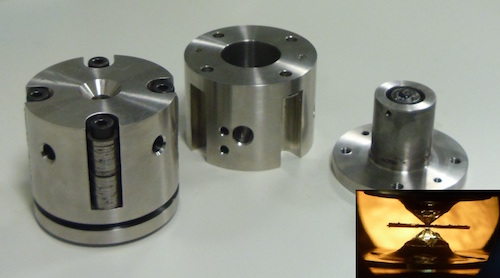
Diamond anvil cell (DAC) assembled ready to apply pressure (left) and disassembled (right). Diamond is visible mounted on the piston. When assembled, the sample is compressed between the culet of this diamond and a second diamond mounted in the cylinder. A metal plate (gasket) is used to hold sample in place laterally. Inset shows side view of diamond culets and gasket after cell is assembled. Pressure is applied by turning the socket cap screws attached to the assembled DAC on the left. The washers act as springs to enable accurate control of pressure.

A selection of DACs in the laboratory. The 3 DACs on left are for compression at ambient temperature compression, the 3 longer piston DACs on the right are for compression at high temperature (with internal and external resistive heaters) and the right hand DAC is for ambient temperature compression using a clamp setup to apply pressure.
Depending on the experiments being performed, the diamonds can last forever or can crack and break frequently. Compression to extremely high pressures (100 GPa+), compression at high temperatures, compression of diffusive low-Z materials such as hydrogen and superhard materials such as boron carbide all increase the risk of diamond breakage. Unfortunately, most worthwhile high-pressure experiments involve extremely high pressures, high temperatures, low-Z materials or superhard materials so diamonds must be viewed as consumables.
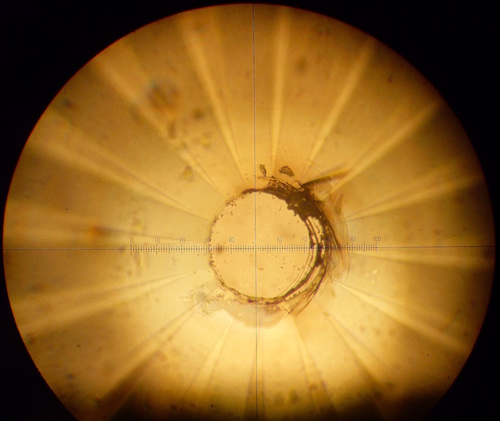
Optical micrograph of damaged diamond culet following compression of silicon-doped boron carbide to 67 GPa.
Diamond is used to compress materials in this way not just due to its superior strength and hardness, but because it is optically transparent allowing samples contained in the DAC under pressure to be probed using X-ray and visible laser photons in-situ. Optical laser spectroscopy (usually photoluminescence or Raman) can be performed on samples contained at high pressures and high temperatures in the DAC using standard tabletop apparatus available in University laboratories.

Near-infrared Raman spectrometer at the University of Salford
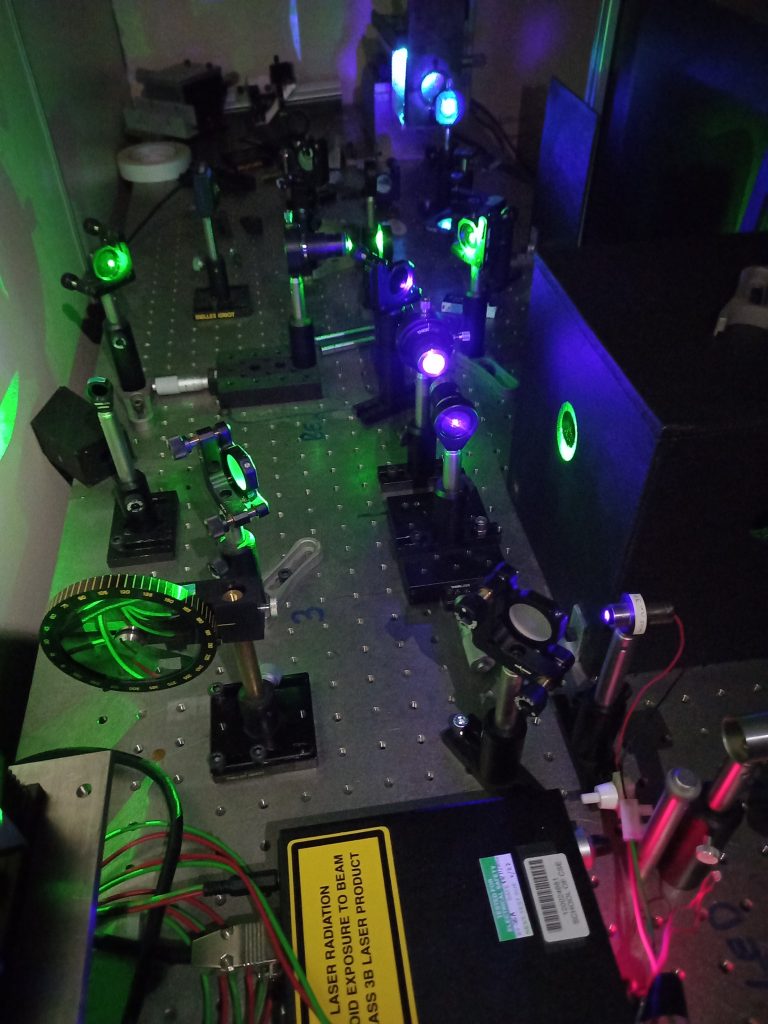
Laser optics on the 532 nm Raman spectrometer at the University of Salford. The blue light is from a 405 nm laser diode used to excite photoluminescence from Sm:YAG to measure pressure at high temperature.
However, while Raman spectroscopy can provide useful information on the behaviour of materials under pressure X-ray diffraction plays a key role as using this technique structures and bulk moduli of materials can be determined directly. Unfortunately to collect good quality X-ray diffraction data on samples compressed in the diamond anvil cell it is necessary to visit a synchrotron X-ray source such as the Diamond Light Source (www.diamond.ac.uk) or European Synchrotron Radiation Facility (www.esrf.eu) since laboratory X-ray sources cannot provide adequate intensity and focussing for DAC experiments. At a synchrotron X-ray source it is also possible to perform X-ray spectroscopy (e.g. XAS) on samples at high pressure.

Dean Smith (Ph.D. student at University of Salford) placing DAC on high-pressure beamline (I15) at Diamond Light Source.
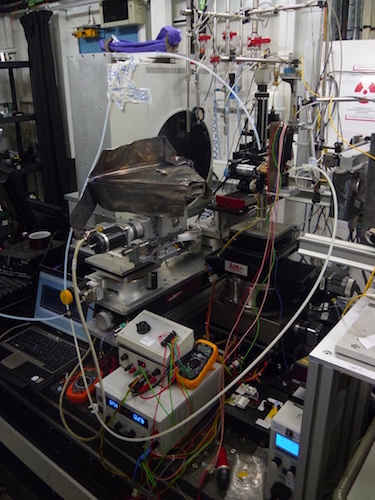
High temperature DAC mounted on high pressure beamline ID27 at the European Synchrotron Radiation Facility, Grenoble, July 2014. Electrical heater is visible clamped round the cell to perform experiment at high pressure and high temperature.
Whilst X-ray diffraction and spectroscopy can be performed on samples inside the DAC, for neutron scattering it is necessary to contain samples using very different (and much larger) apparatus as the technology to focus neutrons to a spot size suitable for DAC studies is not yet widely available. Unfortunately this means that the pressures attainable in neutron scattering experiments are significantly lower than those in X-ray scattering and optical spectroscopy experiments.
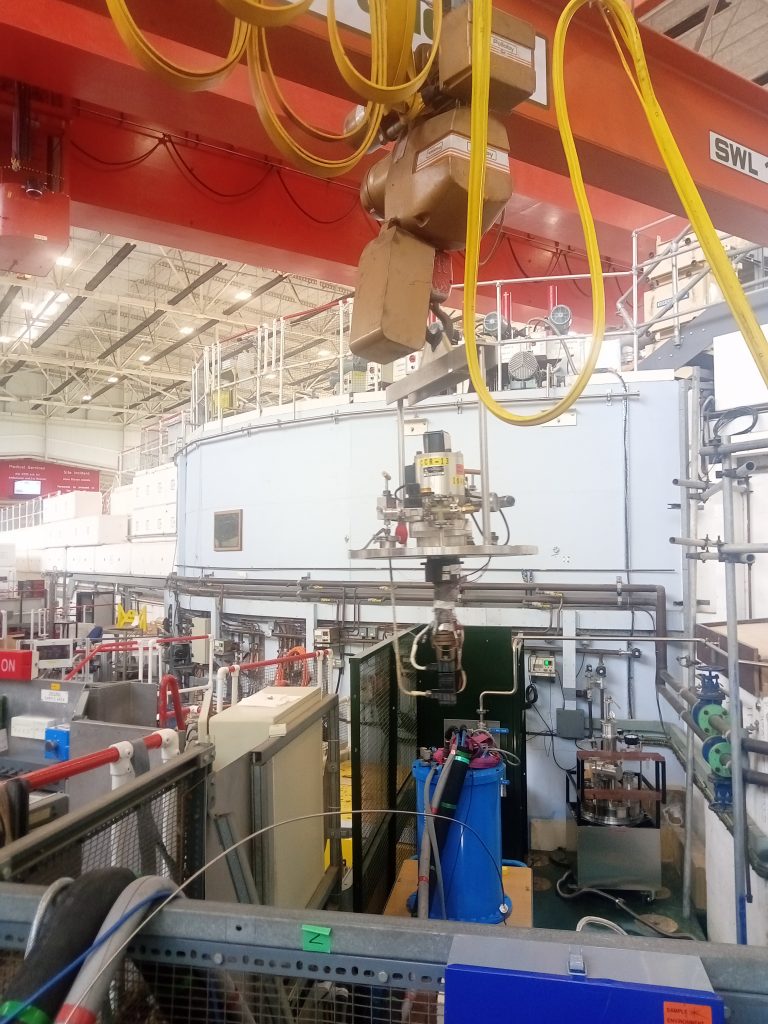
TiZr high pressure cell being lowered onto the SANDALS beamline at ISIS pulsed neutron source in preparation for our experiment in May 2021.